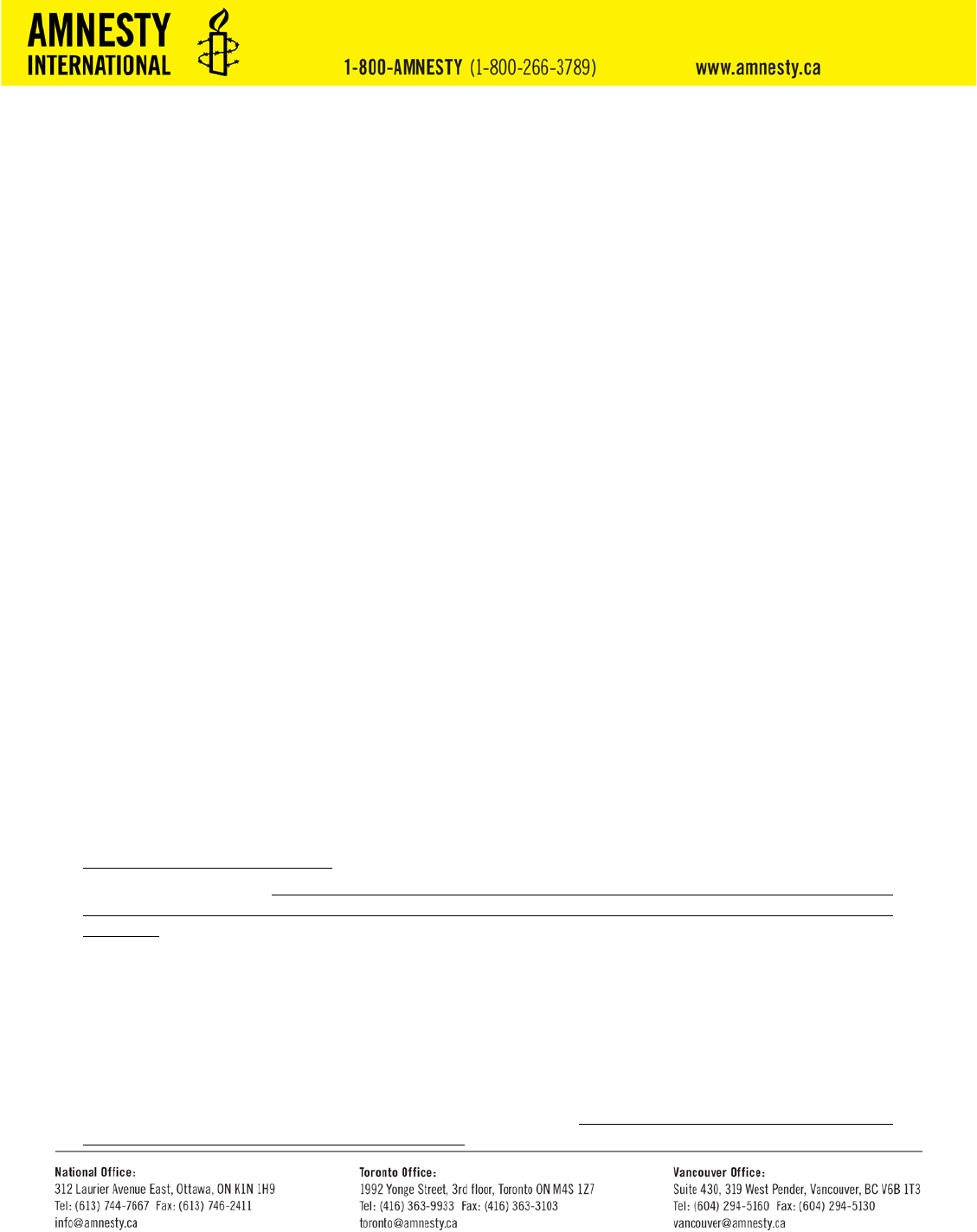
April 1, 2019
AMNESTY INTERNATIONAL SUBMISSION TO STANDING SENATE COMMITTEE ON
HUMAN RIGHTS STUDY ON STERILIZATION WITHOUT CONSENT
Introduction
Forced sterilization occurs when a person is sterilized without their knowledge or informed
consent. “Sterilization under coercion” is when people give their consent to be sterilized,
but on the basis of incorrect information or other coercive tactics such as intimidation, or
that conditions are attached to sterilization, such as financial incentives or access to health
services.
1
Forced or coerced sterilization violates the rights to equality, non-discrimination, physical
integrity, health, privacy, information, family, and security, and constitutes violence
against women.
2
In some cases, it constitutes torture or cruel, inhuman or degrading
treatment or may be a violation of the right to life.
3
International standards recognize the
right of all women and girls to live free from violence and discrimination; to make decisions
about reproduction free from discrimination, coercion or violence; to make free choices
about the number, spacing and timing of their children; and to have access to sexual and
reproductive health information and services.
4
Forced or coerced sterilization of Indigenous women is also an assault on the cultural
integrity of societies that have already endured grave human rights violations, including
forced assimilation. It is worth noting as well that measures to prevent births within
national, ethnic, racial, or religious groups are explicated prohibited by the Convention on
1
Amnesty International, The State as a Catalyst for Violence Against Women: Violence Against Women and
Torture or other Ill Treatment in the Context of Sexual and Reproductive Health in Latin America and the
Caribbean, AMR 01/3388/201, March 2016, p. 28.
2
Convention on the Elimination of all forms of Discrimination Against Women, General Recommendation
24, Article 12, CEDAW/C/AUS/CO/7; Universal Declaration of Human Rights, Article 7; International
Covenant on Economic, Social and Cultural Rights, Articles 12.1 and 16.1; International Convention on the
Elimination of all forms of Racial Discrimination, Article 5; and UN Declaration on the Rights of Indigenous
Peoples, Article 2.
3
UN, Universal Declaration of Human Rights, Article 5; UN, International Covenant on Civil and Political
Rights, Article 7; and Convention against Torture and Other Cruel, Inhuman or Degrading Treatment or
Punishment.
4
OHCHR, UN Women, UNAIDS, UNDP, UNFPA, UNICEF, WHO, “Eliminating Forced, Coerced, or Otherwise
Involuntary Sterilization: An interagency statement,” June 2014.
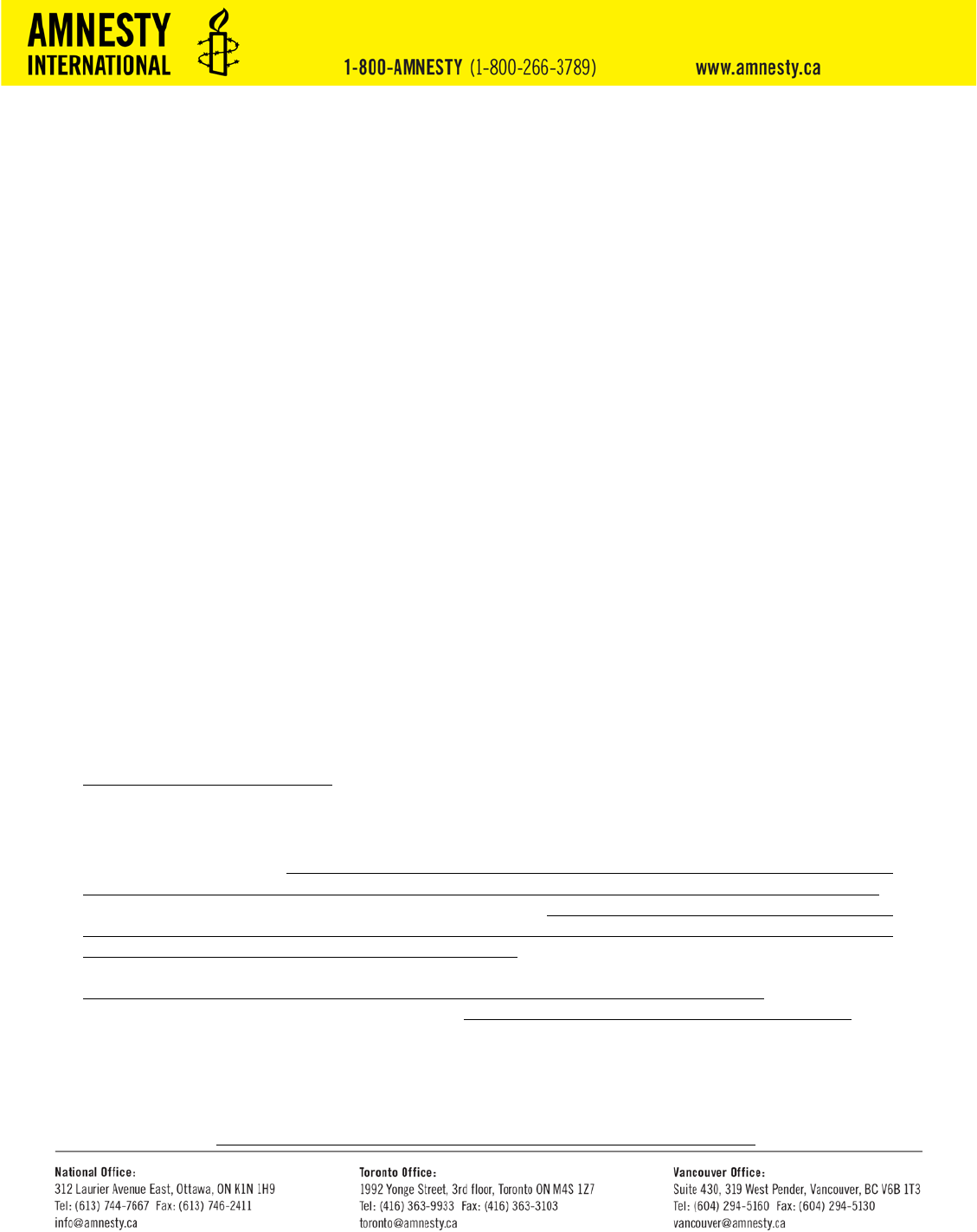
the Prevention and Punishment of the Crime of Genocide
5
as well as one of the specific
elements of the crime of genocide in the Rome Statute of the International Criminal Court.
6
The information that has emerged recently about the pattern of coercive techniques used
to obtain ‘consent’ in Canada is consistent with practices Amnesty International has
documented in Chile, China, Mexico, and, most notably, Peru, where thousands of
Indigenous women were forcibly or coercively sterilized in the 1990s.
7
In 2014, the Inter-
American Commission on Human Rights found that Bolivia violated the right to be free
from torture and ill-treatment in the case of a Peruvian refugee who was sterilized in a
public hospital after a caesarean section. The court also agreed to hear the case of a
woman living with HIV in Chile who was forcibly sterilized.
8
The European Court of Human
Rights found that forced sterilization of Roma women in Slovakia “violates the prohibition
of torture and inhuman or degrading treatment or punishment, as well as other rights
protected by the European Convention on Human Rights.”
9
Sterilization without consent in Canada
Racial bias against Indigenous peoples in the provision of public services in Canada is a
well-known problem and has been acknowledged by governments across the country. There
is little doubt that this discrimination has led to medically unnecessary sterilizations—
mostly tubal ligations—without the patient’s free, full, and informed consent.
Forced or coerced sterilization of Indigenous women in Canada has been documented from
the 1800s to the present.
10
In the 1970s, there were about 1,200 cases of coerced
5
Convention on the Prevention and Punishment of the Crime of Genocide, Article 2 (d). See also, UN
Declaration on the Rights of Indigenous Peoples, Article 8.2.
6
Rome Statute, Article 6(d): Imposing measures intended to prevent births within the group.
7
Amnesty International, “They never saw me as a person, they saw me as an incubator: How the state
promotes violence against women – sexual and reproductive health in Latin America and the Caribbean,”
AMR 01/4140/2016, March 2016; Amnesty International, The State as a Catalyst for Violence Against
Women: Violence Against Women and Torture or other Ill Treatment in the Context of Sexual and
Reproductive Health in Latin America and the Caribbean, AMR 01/3388/201, March 2016; and Amnesty
International, “Thousands at risk of forced sterilization in China,” 22 April 2010,
https://www.amnesty.org/en/latest/news/2010/04/thousands-risk-forced-sterilization-china/.
8
Inter-American Commission on Human Rights, “Report No. 72/14, Case 12.655 Merits I.V. Bolivia,” 15
August 2014; and Inter-American Commission on Human Rights, “Report No. 52/14, Petition 112-09,
Admissibility F.S. Chile, 21 July 2014.
9
Cynthia Soohoo and Farah Diaz-Tello, American University, “Torture and Ill-Treatment: Forced Sterilization
and Criminalization of Self-Induced Abortion” in Gender Perspectives on Law and Torture: Law and Practice,
American University, p. 283.
10
Maurice Law, “Request for a thematic hearing on the forced sterilization of Indigenous
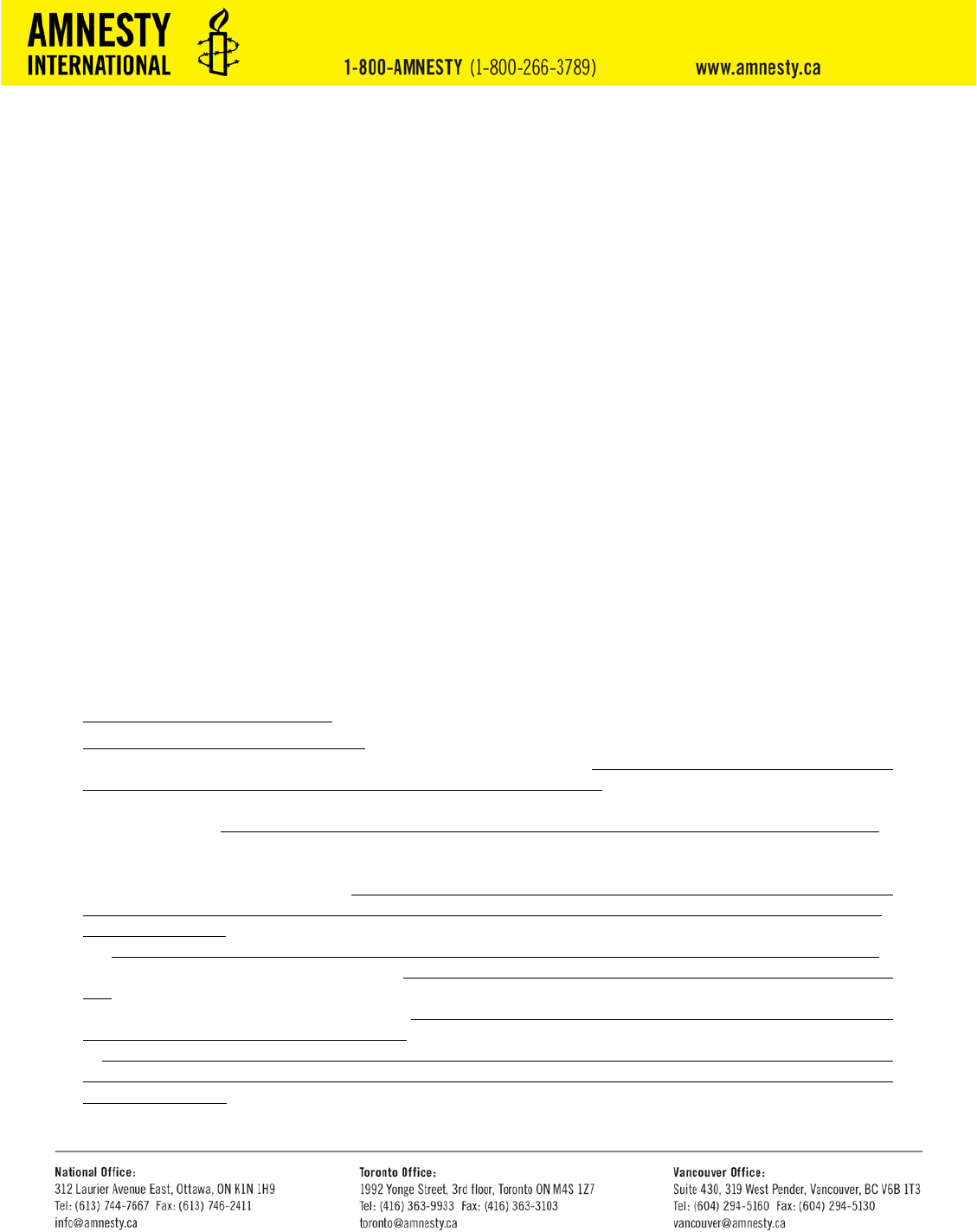
sterilization of Indigenous women, reportedly intended to reduce the numbers of
Indigenous persons in Canada.
11
It is unknown how many Indigenous people in Canada
have been sterilized without their consent, but there is compelling evidence that the
practice has not ceased.
12
In July 2017, the Saskatoon Regional Health Authority released the report of an external
review commissioned after at least four Indigenous women reported in the media that they
had been coercively sterilized in a Saskatoon hospital, primarily between 2008 and
2012.
13
The report documented the experiences of 16 women, most of whom reported
being coercively sterilized between 2005 and 2010, and noted that “pervasive structural
discrimination and racism in the health care system in general (despite attempts to remedy
these) remains unmistakable.”
14
A class action law suit filed in Saskatchewan in October 2017 began with two Indigenous
women who report being sterilized without their consent.
15
Waves of media coverage of the
issue in the fall of 2018 led to over 100 more Indigenous women from five provinces
(Alberta, British Columbia, Manitoba, and Ontario) coming forward with allegations that
they too were sterilized without their free, full, and informed consent.
16
All but one of the women who allege they were sterilized without their consent are
women in Canada, File no. 434.01,” Submission to Inter-American Commission on Human Rights, 6
December 2017; and Dr. Judith Bartlett and Dr. Yvonne Boyer, External Review: Tubal Ligation in the
Saskatoon Health Region: The Lived Experience of Aboriginal Women, Saskatoon Regional Health Authority,
2017.
11
Roger Collier, “Reports of Forced Sterilization of Indigenous Women in Canada Mirror Shameful Past,”
Canadian Medical Association Journal, Vol. 21, Issue 33, August 2017.
12
“Indigenous women kept from seeing their newborn babies until agreeing to sterilization, says lawyer,”
CBC, 13 November 2018,
https://www.cbc.ca/radio/thecurrent/the-current-for-november-13-2018-
1.4902679/indigenous-women-kept-from-seeing-their-newborn-babies-until-agreeing-to-sterilization-says-
lawyer-1.4902693.
13
“Saskatoon health region apologies after aboriginal women felt pressured by staff to have tubed tied,”
National Post, 17 November 2015; and “Another Saskatoon Woman Says She Was Sterilized Against Her
Will,” CBC, 16 December 2015.
14
Dr. Judith Bartlett and Dr. Yvonne Boyer, External Review: Tubal Ligation in the Saskatoon Health Region:
The Lived Experience of Aboriginal Women, Saskatoon Regional Health Authority, 2017, p. 31.
15
M.R.L.P and S.A.T. v The Attorney General of Canada, the Government of Saskatchewan, Saskatchewan
Health Authority, Athabasca Health Authority, Dr. Kristine Mytopher, Dr. Ahmed Ezzat, Dr. Ian Lund, John
Doe, and Jane Doe, QB 1485 (2017), filed 16 February 2018; and meeting with Alisa Lombard, Maurice
Law, Ottawa, 15 March 2018.
16
Interview with Alisa Lombard, Maurice Law, 27 February 2019.
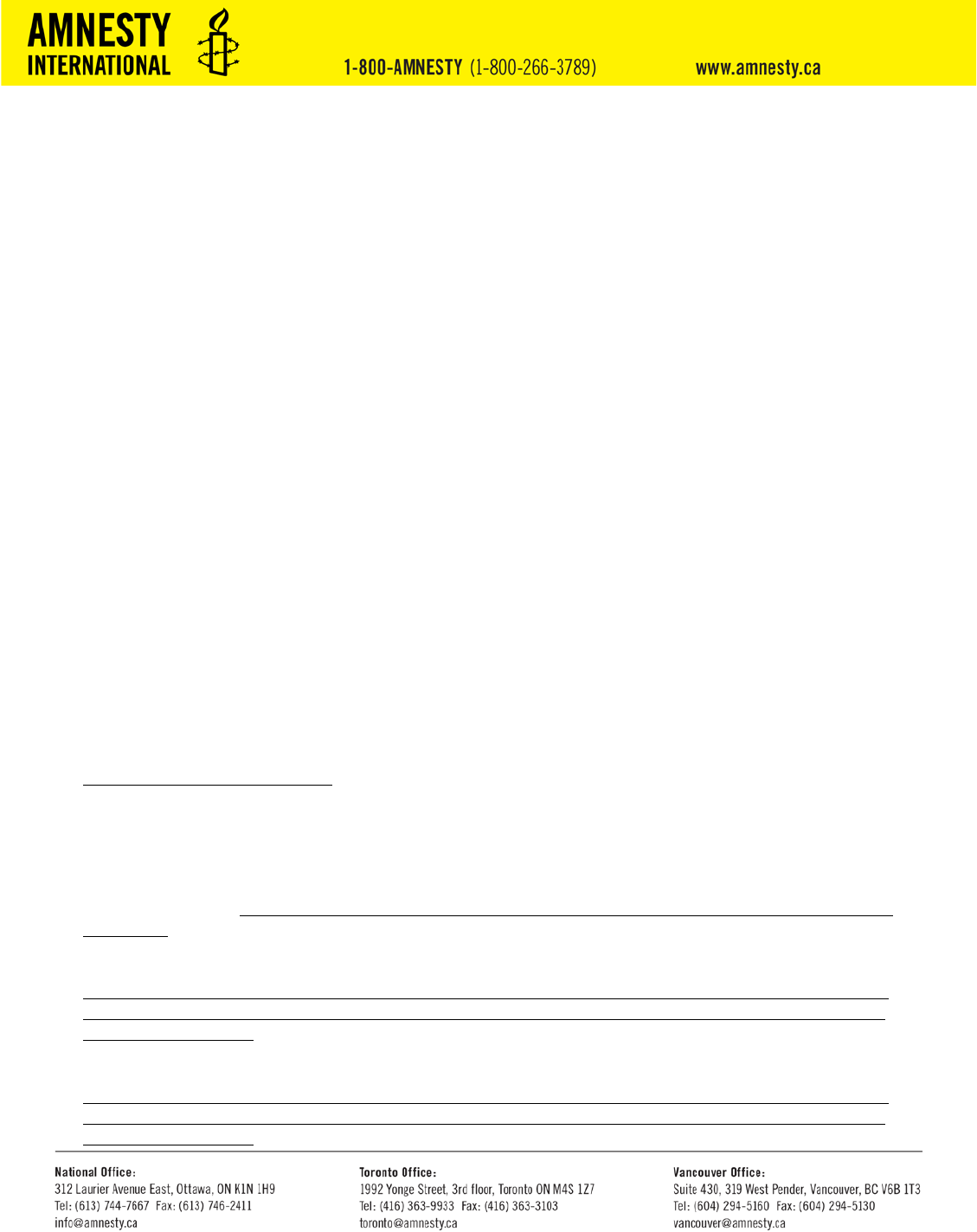
Indigenous women.
17
It is possible that non-Indigenous women have also been sterilized
without their consent. It has been well documented that, “forced sterilization is
disproportionately practiced on those from stigmatized groups, such as women living with
HIV, poor women, ethnic or national minorities, women with disabilities, and gender non-
conforming individuals.”
18
Government action to address sterilization without consent
must recognize that multiple and intersecting forms of discrimination may place some
groups of women at a heightened risk of being sterilized without their consent.
Sterilization without consent is torture
In December the UN Committee on Torture (UNCAT) affirmed that forced and coerced
sterilization of women in Canada is a form of torture.
19
As a State Party to the UN Convention Against Torture, Canada’s record on preventing and
addressing torture and other forms of ill-treatment is periodically reviewed by the UN
Committee Against Torture. Canada’s most recent review took place in November 2018 in
Geneva, and its final report was issued on 7 December 2018. The report called on Canada
to “ensure that all allegations of forced or coerced sterilization are impartially investigated,
that the persons responsible are held accountable and that adequate redress is provided
to the victims.”
20
The report also called on Canada to adopt laws and policies to prevent and criminalize
sterilization without consent, and to clearly define “the requirements of free, prior and
informed consent with regard to sterilization and by raising awareness among Indigenous
women and medical personnel of that requirement.”
21
17
Interview with Alisa Lombard, Maurice Law, 27 February 2019.
18
Cynthia Soohoo and Farah Diaz-Tello, American University, “Torture and Ill-Treatment: Forced Sterilization
and Criminalization of Self-Induced Abortion” in Gender Perspectives on Law and Torture: Law and Practice,
American University, p. 283.
19
Amnesty International, “Sterilizing Indigenous Women without Consent is Torture, says UN Committee,”
7 December 2018,
www.amnesty.ca/news/sterilizing-indigenous-women-without-consent-torture-says-un-
committee.
20
UN Committee against Torture, “Concluding observations on the seventh periodic report of Canada,”
CAT/C/CAN/CO/7, 21 December 2018,
http://docstore.ohchr.org/SelfServices/FilesHandler.ashx?enc=6QkG1d%2fPPRiCAqhKb7yhsglSZMQd1BoE
akgym8DLljp%2ftVZwAcP32UhceoEv6s9EFDnHa%2ffIXxFR9KNVY4qkr3X7%2faP5eVqCmw6nDLJyD3dA
5iGzIWJ0XfsLEbi0yIvz.
21
UN Committee against Torture, “Concluding observations on the seventh periodic report of Canada,”
CAT/C/CAN/CO/7, 21 December 2018,
http://docstore.ohchr.org/SelfServices/FilesHandler.ashx?enc=6QkG1d%2fPPRiCAqhKb7yhsglSZMQd1BoE
akgym8DLljp%2ftVZwAcP32UhceoEv6s9EFDnHa%2ffIXxFR9KNVY4qkr3X7%2faP5eVqCmw6nDLJyD3dA
5iGzIWJ0XfsLEbi0yIvz.
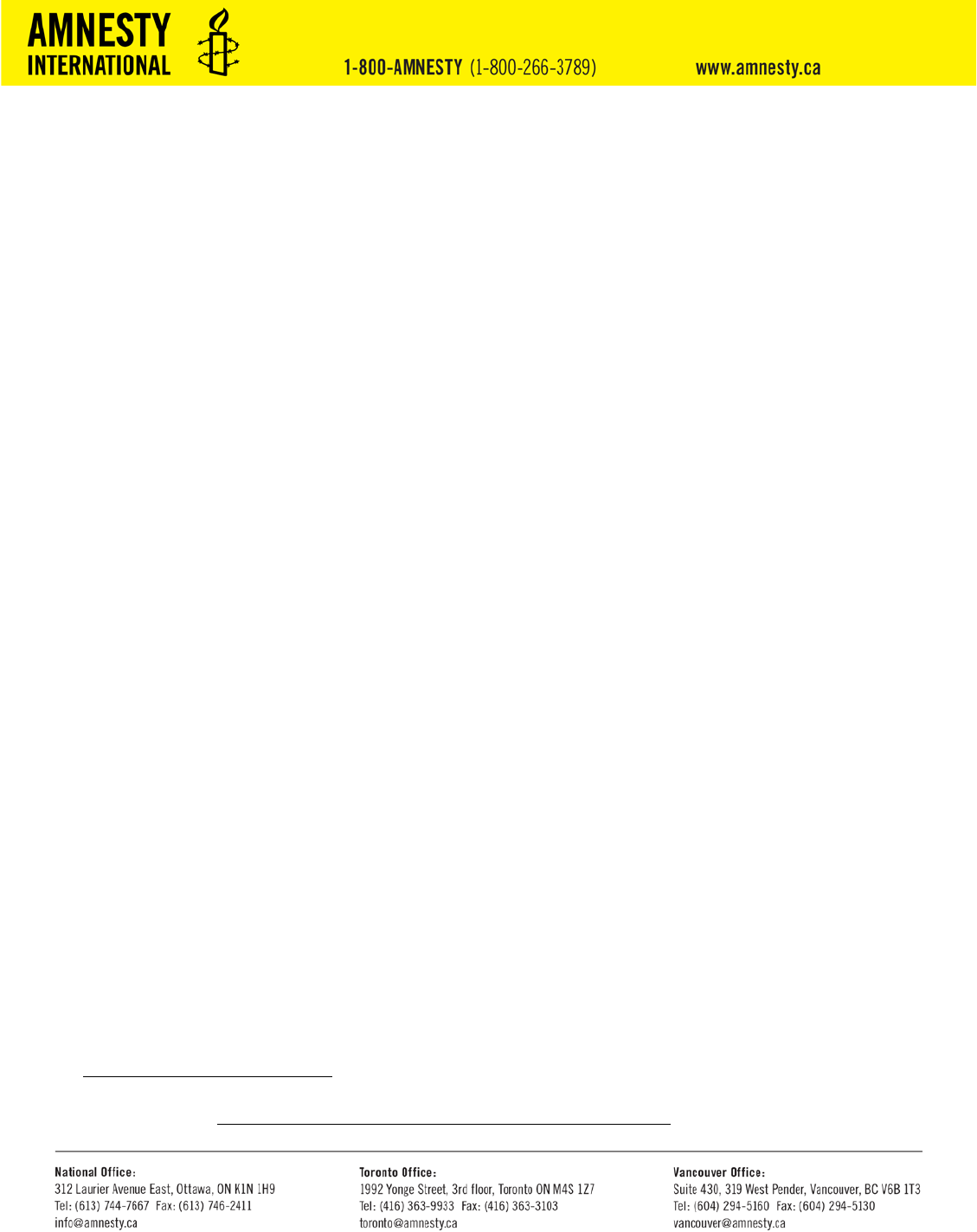
According to Article 1 of the Convention against Torture, torture includes any act that is
intentionally inflicted and results in physical and/or mental pain or suffering serious
enough to be considered severe; is committed by state officials, either directly or indirectly;
and is committed for specified reasons, including “any reason based on discrimination of
any kind.”
22
Sterilization of Indigenous women in Canada meets all these elements of the
definition and as such clearly contravenes the absolute prohibition of torture and other ill-
treatment.
In its Concluding Observations on Canada, the Committee signaled that this deeply
troubling human rights concern is of such urgency that Canada has been asked to provide
an interim progress report by December 2019, rather than waiting for Canada’s next review
by the Committee in five or six years. This means that the Committee has put forced or
coerced sterilization high on the list of issues that need to immediately be addressed when
it comes to preventing and addressing torture and other ill-treatment in Canada.
Inadequate federal response
The federal government has the jurisdictional authority and the obligation to ensure that
the UN Committee on Torture’s recommendations are implemented across all provinces
and territories in Canada. Furthermore, federal government coordination and leadership is
essential to ensuring a consistent, country-wide approach to addressing this pressing
human rights concern. Such an approach must involve survivors, Indigenous women’s
organizations, human rights organizations, provinces, territories, and medical bodies.
To ensure justice and redress is provided to survivors, as recommended by the UN
Committee on Torture, government officials must meet with survivors and their families as
a first step in determining how to compensate survivors for the pain and suffering they
have endured. To Amnesty International’s knowledge, the federal government has made
no effort to meet with survivors and their representatives, or to appoint a high-level focal
point to do so.
While expressing concern over reports of forced and coerced sterilization, the federal
government has been hesitant to take concrete action to implement the UN Committee’s
recommendations. In February 2019, the House of Commons Standing Committee on
22
UN, “Convention against Torture and Other Cruel, Inhuman or Degrading Treatment or Punishment,” 10
December 1984, https://www.ohchr.org/en/professionalinterest/pages/cat.aspx.
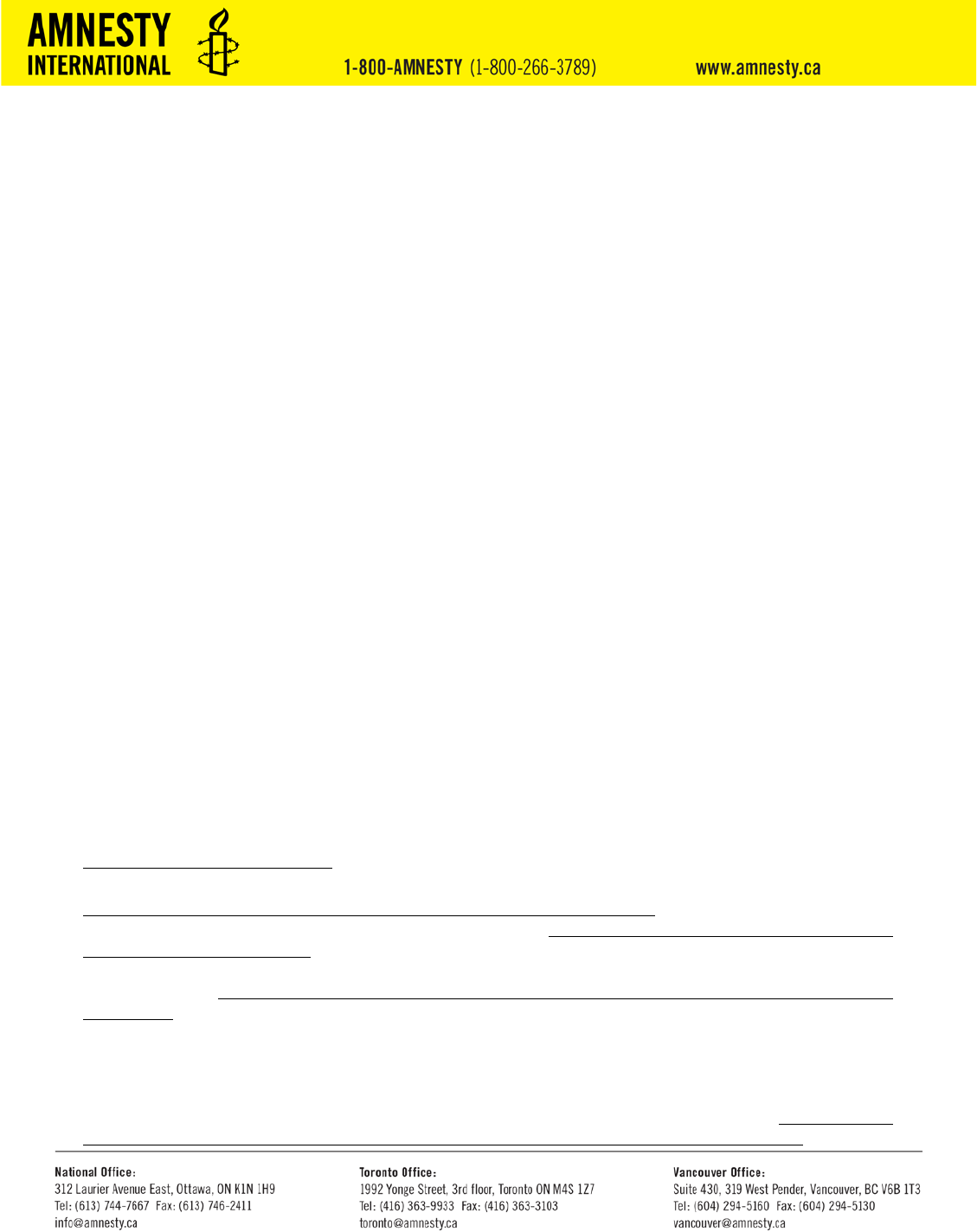
Health approved a brief study of forced sterilization of women in Canada, but placed the
study at the bottom of the committee’s priority list, meaning the study may not occur
before the upcoming federal election.
23
The federal government created a “(federal,
provincial and territorial) working group of senior officials to engage with Indigenous groups
and national provider organizations on measures to improve cultural safety in health
systems.” However, little information about this working group is publicly available, and
not all provinces are participating in it.
24
The working group’s focus on culturally safe healthcare is consistent with the federal
government’s approach to addressing sterilization without consent. Culturally safe health
care is an important concern, and something Amnesty International has advocated for, but
such an approach must incorporate and be supported by a clear position on the absolute
necessity of consent.
The Inter-American Court of Human Rights and the European Court of Human Rights have
recognized that “informed consent can never be given during and immediately after labour
and delivery,” that sterilization without consent cannot be “justified as an emergency
procedure based upon the danger posed by a future pregnancy” because “sterilization is
not a life-saving medical intervention.”
25
UN Special Rapporteur on Torture Juan E.
Mendéz stated that “in response to reports of sterilizations of women in 2011, the
International Federation of Gynaecology and Obstetrics emphasized that ‘sterilization for
prevention of future pregnancy cannot be ethically justified on grounds of medical
emergency. Even if a future pregnancy may endanger a woman’s life or health, she ... must
be given the time and support she needs to consider her choice. Her informed decision
must be respected, even if it is considered liable to be harmful to her health.’”
26
Whether an Indigenous woman births with a traditional midwife in a rural area or with a
23
Standing Committee on Health, “Minutes of Proceedings,” (31 January 2019),
www.ourcommons.ca/DocumentViewer/en/42-1/HESA/meeting-131/minutes
; and Standing Committee on
Health, “Minutes of Proceedings” (5 February 2019), www.ourcommons.ca/DocumentViewer/en/42-
1/HESA/meeting-132/minutes.
24
Quebec declines talks with feds, provinces, territories on coerced sterilization, The Canadian Press, 15
February 2019,
https://www.cbc.ca/news/indigenous/quebec-declines-working-group-coerced-sterilization-
1.5021765.
25
Cynthia Soohoo and Farah Diaz-Tello, American University, “Torture and Ill-Treatment: Forced Sterilization
and Criminalization of Self-Induced Abortion” in Gender Perspectives on Law and Torture: Law and Practice,
American University, p. 285.
26
Juan E. Mendéz, “Report of the Special Rapporteur on torture and other cruel, inhuman or degrading
treatment or punishment, Juan E. Méndez,” A/HRC/22/53, 1 February 2013, p. 8,
https://www.hr-
dp.org/files/2014/07/20/Report_of_the_Special_Rapporteur_on_Torture,_1_February_2013.pdf.

doctor in an urban hospital, her free, full, and informed consent must be secured before
undergoing any medical procedures. Sterilization without consent will not cease until the
issue of free, full, and informed consent is fully and meaningfully addressed by
government.
Calls for action
Amnesty International, alongside other organizations, and critically, Indigenous women’s
organizations, have called on the federal government to take urgent action. Specifically,
the organization has called on the federal government to:
• thoroughly investigate all allegations of forced or coerced sterilizations of
Indigenous women in Canada;
• establish policies and accountability mechanisms across Canada that provide clear
guidance on how to ensure sterilizations are only performed with free, full, and
informed consent; and
• provide access to justice for survivors and their families.
As critical next steps, Amnesty International is calling on the federal government to:
1. Appoint a special representative to meet with survivors and their families, to hear
their requests for justice and reparations.
2. Meet with provinces, territories, health bodies, and civil society, including
Indigenous women’s organizations, human rights organizations, and reproductive
health associations.
3. Conduct a formal investigation into allegations of forced or coerced sterilizations in
Canada, so as to better understand the scale and scope of this issue, taking a
trauma-informed, survivor-centred approach, and with particular attention to cases
involving Indigenous women and girls. As a first step, the Canadian Institute for
Health Information (CIHI) should be tasked with compiling all relevant information
about sterilization.
4. Clarify the process by which free, full, and informed consent must be obtained prior
to any medical procedure, to ensure that women and healthcare providers across
Canada are clear on the process for obtaining consent.
5. Support healthcare providers in promoting a full range of sexual and reproductive
health information and services across Canada.
6. Apply existing criminal legislation on torture and aggravated assault as warranted
for cases of forced or coerced sterilization.
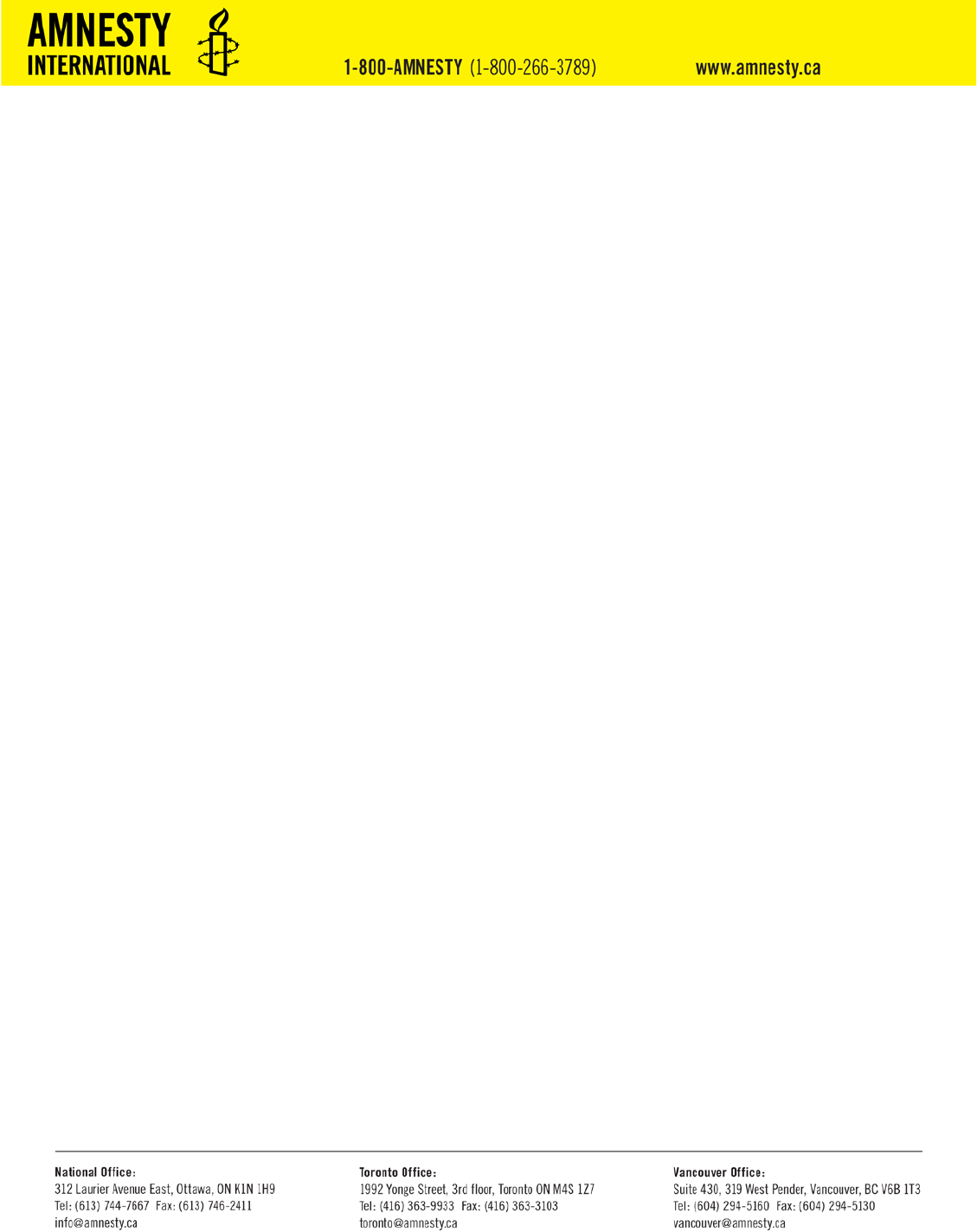
7. Explore amending the Criminal Code to make forced and coerced sterilization a
specific offense to increase its visibility and better support prosecution of cases of
sterilization without consent.
8. Implement Truth and Reconciliation Commission Calls to Action 23 and 24 on
increasing the number of Indigenous healthcare professionals and providing
cultural competency training to all healthcare professionals.
9. Develop a comprehensive National Action Plan to prevent and address gender-based
violence involving the federal government, provinces, territories, municipalities, and
First Nations.
